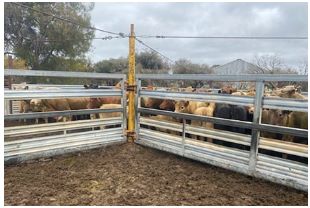Preparing the yards
Having well designed, easy to access, well maintained yards and livestock handling facilities reduces the risk of stress and potential injuries to people and livestock before and after transport.
handling facilities reduces the risk of stress and potential injuries to people and livestock before and after transport.
The most dangerous part of transport is loading and unloading. Safe design and low stress handling methods will help reduce risks to people and livestock.
Checklist for yard preparation
|
General design principles
The Australian Livestock and Rural Transporter’s Association's (ALRTA) Guide for Safe Design of Livestock Loading Ramps and Forcing Yards suggests the following on design:
Work health and safety laws recognise that what is ‘reasonably practicable’ for different facilities can vary depending upon factors such as frequency of use and exposure, type of stock being handled and environmental conditions. However, there are some general design principles that should be applied to all livestock loading facilities regardless of their size. These include:
Consider the primary aim:
-
Separation of people and livestock should be ensured.
-
Facilities should minimise safety and welfare risks and promote smooth ‘flow’ of livestock.
Consider the intended use:
-
Ramps should be constructed appropriate to the species of stock and vehicles used.
-
Ramps should be aligned north-south to avoid loading into the sun.
-
Noise and visual distractions should be minimised.
-
If the facility will be used at night, adequate overhead lighting should be provided to evenly illuminate pens, loading areas and vehicles to encourage safe animal movement.
-
Ramps should be built to enable single operator use and ease of operation (Note: For safety, it is advisable that ramps are not operated by a single person. However, where appropriate, the ramp design should take into account that this is sometimes unavoidable).
Get the design right:
-
Facility operators should consult with facility users to assist in the initial design phase.
-
Hazards should be addressed through good design in preference to management controls.
-
Use non-slip (easy to clean) and non-bruising materials throughout.
-
Engineer’s information and statutory requirements should be referenced when designing new ramps or replacing bolts, cabling and hardware to maintain a safe working load limit.
Maintain safety standards:
-
Facility operators should regularly consult with facility users to assist in the early identification of emerging safety risks.
-
Facilities should be clean and in a good state of repair.
-
Rated capacity should be displayed on the ramp and the working load limit displayed on any winch/hoist.
-
Winches must comply with AS 1418.2 1997 and friction clutches are recommended.
-
Persons using the facility should be appropriately trained according to their role.
-
Signage should display emergency contact details for the facility operator.
-
Facility users should report all faults or safety issues to management.
-
Review relevant hazards, risks and controls periodically and after an incident or near miss.
Guidelines for ramps and yards
-
The Australian Standard for Livestock Loading/Unloading Ramps and Forcing Pens.
-
Australian Livestock and Rural Transporter’s Association’s ‘Guide for safe design of livestock loading ramps and forcing yards’-(ALRTA)
Checklist for yard preparation:
-
I have provided adequate access for trucks to:
-
enter my property
-
be able to comfortably manoeuvre the vehicle
-
back in and/or side load at the loading ramp.
-
-
I have considered the impact of adverse weather conditions on road access.
-
Yards are designed in accordance with good design principles where possible.
-
Effluent management has been incorporated.


